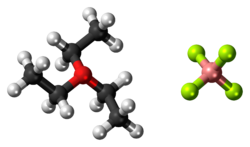Triethyloxonium tetrafluoroborate
 |
|
 |
|
| Names | |
|---|---|
|
IUPAC name
Triethyloxonium tetrafluoroborate
|
|
| Identifiers | |
|
3D model (JSmol)
|
|
| 3598090 | |
| ChemSpider | |
| ECHA InfoCard | 100.006.096 |
|
PubChem CID
|
|
| UN number | 3261 |
|
|
|
|
| Properties | |
| C6H15BF4O | |
| Molar mass | 189.99 g·mol−1 |
| Melting point | 91 to 92 °C (196 to 198 °F; 364 to 365 K) |
| Reacts | |
| Hazards | |
|
EU classification (DSD) (outdated)
|
|
| R-phrases (outdated) | R14, R34 |
| S-phrases (outdated) | S22, S26, S36/37/39 |
|
Except where otherwise noted, data are given for materials in their standard state (at 25 °C [77 °F], 100 kPa).
|
|
|
|
|
| Infobox references | |
Triethyloxonium tetrafluoroborate is the organic oxonium compound with the formula [(CH3CH2)3O]BF4. It is often called Meerwein's Reagent or Meerwein's Salt after its discoverer Hans Meerwein. Also well known and commercially available is the related trimethyloxonium tetrafluoroborate. The compounds are white solids that dissolve in polar organic solvents. They are strong alkylating agents. Aside from the BF−
4 salt, many related derivatives are available.
Triethyloxonium tetrafluoroborate is prepared from boron trifluoride, diethyl ether, and epichlorohydrin:
The trimethyloxonium salt is available from dimethyl ether via an analogous route. These salts do not have long shelf-lives at room temperature. They degrade by hydrolysis:
The propensity of trialkyloxonium salts for alkyl-exchange can be advantageous. For example, trimethyloxonium tetrafluoroborate, which reacts sluggishly due to it low solubility in most compatible solvents may be converted in situ to higher alkyl/more soluble oxoniums, thereby accelerating alkylation reactions.
The compound features a pyramidal oxonium cation, isoelectronic with triethylamine, and a tetrahedral fluoroborate anion. Reflecting its ionic character, the salt dissolves in polar but inert solvents such as dichloromethane, sulfur dioxide, and nitromethane.
Triethyloxonium tetrafluoroborate is a strong alkylating agent, although the hazards are diminished because it is non-volatile. It releases strong acid upon contact with water. The properties of the methyl derivative are similar.
...
Wikipedia
